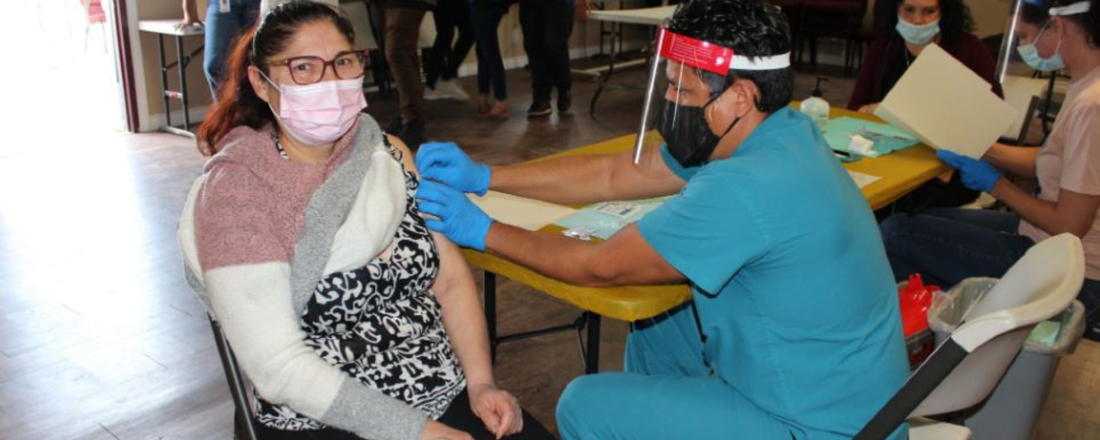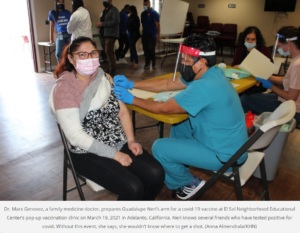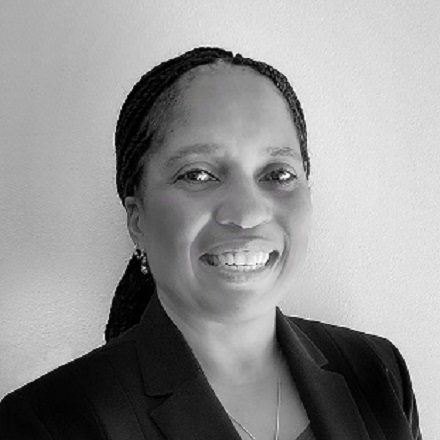
In the News
Beating the Pavement to Vaccinate the Underrepresented — And Protect Everyone
- California Healthline
-
Focus Areas
Communicable Disease Prevention, Healthy Communities -
Issues
Rural Health -
Programs
Together Toward Health -
Strategic Initiatives
COVID-19

Lea una versión de este artículo en español aquí
Leonor Garcia held her clipboard close to her chest and rapped on the car window with her knuckles. The driver was in one of dozens of cars lined up on a quiet stretch of road in Adelanto, California, a small city near the southwestern edge of the Mojave Desert. He was waiting for the food bank line to start moving and lowered the passenger window just enough to hear what Garcia wanted. Then she launched into her pitch.
“Good morning! We’re here to talk about COVID-19 today! Do you have a minute?” she said in Spanish.
After a brief conversation, Garcia learned the man had no internet connection or phone of his own but was 66 years old and wanted to get the COVID vaccine. He had tried to visit a pharmacy in person, but the shots were all out for the day. Garcia took down his name and the phone number of a friend, so she could reach the driver later about a mobile vaccine clinic that her organization, El Sol Neighborhood Educational Center, was putting together for the remote desert city sometime in April.
The country needs to get the vaccination rate to about 75% to keep the virus from easily spreading — a level called herd immunity by experts on infectious diseases. But even that figure assumes the population is homogenous in terms of vaccination. That’s why the state’s ability to stave off another COVID surge may rely on people like Garcia and Marroquin — community health workers and organizers doing time-intensive, laborious work — to prevent pockets of the population with low vaccination rates in remote or isolated communities from becoming a tinderbox for a new covid surge.
“When you have geographical or social pockets of unvaccinated people, it really messes up herd immunity,” said Daniel Salmon, director at the Institute for Vaccine Safety at Johns Hopkins University’s Bloomberg School of Public Health.
As of March 26, most of the more than 15.9 million vaccine doses distributed since December have gone to the healthiest, wealthiest places in the state. Community-based organizations like nonprofits and churches are clamoring for more funding — and trust — to carry the vaccine the final mile to the people they’ve been serving for years.
El Sol’s success in getting Black, Latino and other underrepresented populations vaccinated debunks the idea that these groups won’t get the shot, said Juan Carlos Belliard, assistant vice president for community partnerships at Loma Linda University Health in San Bernardino County. Loma Linda is collaborating with El Sol to staff and provide doses for clinics. The people who show up are ready for their vaccine, though some are a bit hesitant, he said.

“They’re not like our middle-class folks who are literally crying for the vaccine,” Belliard said. “These folks are still nervous about it, but you’ve removed almost all of these other barriers for them.”
El Sol’s community workers were funded by a $52.7 million combined effort from state and philanthropic funding that provided grants to 337 organizations considered “trusted messengers” in their communities. The money was pushed out to groups like El Sol that had proven track records of shoe-leather canvassing for voter registration or census surveys.
El Sol received $120,000 from the public-private initiative to support its general outreach and educational efforts for COVID vaccination. But the group was in the dark about whether it would get any reimbursement for the mobile vaccination events it has organized in San Bernardino County, said executive director Alex Fajardo.
The group plans to do three more vaccination pop-ups in the High Desert area. But future support for its clinics, vaccine outreach and education are murky, said Fajardo.
“What is going to happen after?” he said. “When we need you, we pay you. When we don’t need you, ‘Bye-bye.’”

That’s a very fair assessment. There’s an opportunity here for people to be thinking about the future, and how we do things that doesn’t necessarily leave community groups permanently on the outside, only tapped into when there’s an emergency.Susan Watson, MPH, program director, Together Toward Health
Dr. Mark Ghaly, the state’s secretary for health and human services, promised to provide more money for groups that are getting their communities vaccinated. “This is not a volunteer job,” he told KHN at a news briefing. “This is real work, and I want to be part of the team that makes that a reality for all of them.”
Los Angeles County department of public health Director Barbara Ferrer echoed that sentiment. “They were there before the pandemic started, they’ve been there the entire time during the pandemic, and they’ll be here long after the pandemic,” she said.
Whether or not those promises hold up, community groups say they want to be part of the vaccination effort.
“Even if they don’t give us money, we’ll keep doing the work,” said Fajardo.
Click below to read the full story in California Healthline.
Originally published by California Healthline
More Updates
Work With Us
You change the world. We do the rest. Explore fiscal sponsorship at PHI.
Support Us
Together, we can accelerate our response to public health’s most critical issues.
Find Employment
Begin your career at the Public Health Institute.



